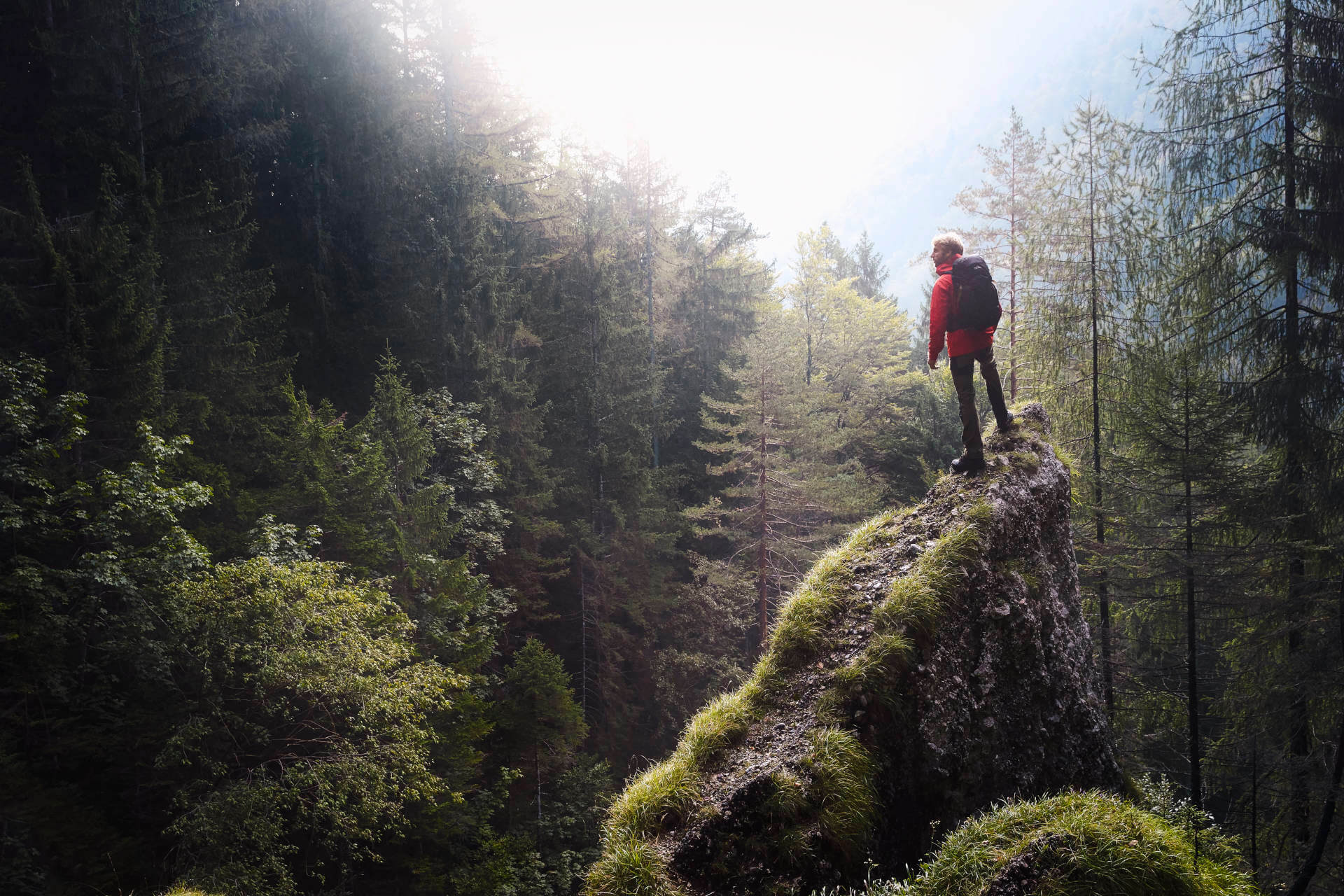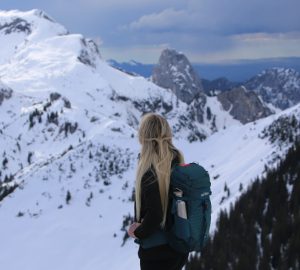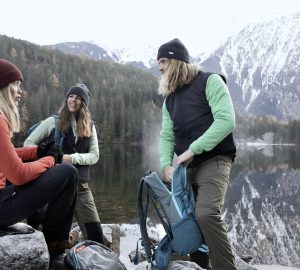Hiking is definitely the best outdoor activity for allowing everyone at any time to adjust to their own condition and abilities. As an interesting variant for those adventure-hungry outdoor enthusiasts, our outdoor expert Michi Bösiger, enthusiastic and experienced hiker and adventure trainer, presents “hiking in the wilds” with many useful tips.
“Hiking in the wilds” – what does this mean?
Hiking is the simplest form of activity out in natural surroundings. You
don’t need much gear and not a lot of specialist knowledge.
The
adventure value can be increased considerably when you face the
challenge of getting around in areas without trails paths. Here you need
a little more experience as well as courage and intuition, a sense of
orientation and feeling for the territory. In this case too, good
preparation and really practical equipment are essential.
It is a good idea to ask yourself a few questions beforehand:
- What is the weather going to be like?
- Can I find my way with the help of a hiking map?
- Do I know the nature conservation areas which are off-limits to the public? Nowadays these are mostly marked on hiking maps.
- Is my equipment really suitable in practical use?
- Who is going with me?

Possibilities for hiking in the wilds
It is particularly appealing to follow a river, either for part of its course or perhaps from the estuary to its source. The route is then fixed but it is important to be aware of the fact that you are out in the wilderness. Mostly short detours have to be made; a section may not be passable (waterfall / rock barrier/ too dense undergrowth) and can make directly following the course of the river impossible in parts. The rule is always “safety first” and you should never take too great a risk.
You discover new things in an area that you may already know, simply by hiking right through the middle of it! On such a hike however, you should still always have a map of the area with you. The guiding principle here is: The journey is the reward.
A further adventure possibility is planning a two-day hike with an overnight stay. In this case it is recommended that you take a tarp with you – it is multifunctional and provides ideal protection from sun or rain. The most important rule is: I try to leave the place where I spent the night in the same condition as I found it.
Also interesting: Camping in the wilds – Rules for undisturbed outdoor nights
Behavior out in nature
Of course many of the following points are obvious: You should avoid making unnecessary noise so that you don’t frighten away the wildlife. You accept that access is prohibited in some areas. You try to keep any damage caused to the minimum (plants, animals, topography). All waste should be taken away with you. After all, in the wilderness you are only a short-term visitor.
Fires should be made on stones if possible and must be extinguished completely before leaving the site. It is a super idea to grill fish or meat on a hot stone. In order to get hot water for tea or coffee you can put a stainless steel bottle of water on the fire (don’t forget to first remove the cap to avoid pressure build up). The most important rule is to fit in with your surroundings and not to force anything.
Tips for moving forward
Crossing a river
When crossing a broad river the “St. Christopher Method” is called for: We look for a strong wooden stick about two meters long. With this stick and with legs apart this forms a stable triangle. We cross the river moving sideward and bent slightly forwards, always looking upstream. Holding the stick in both hands you press it into the river bed about a meter in front of you.Your rucksack stays on your back and its weight gives extra stability.

Caution: It becomes critical as soon as the water rises above your hips as then the water begins to carry you. It is important to leave your boots on as only this way can we have a secure hold on the ground.
If there is no ford over the river then – you will have to swim. Your rucksack must then either be packed in a protective cover sack or you have already packed your gear into smaller, waterproof bags (e.g. TATONKA storage bags).
The rucksack should now be tied securely to the rope and when swimming across the lake or river, ideally of course, where there is the least current. Caution: In flowing waters you should never tie yourself to a rope because if this rope gets caught in an obstacle then, like the water pressure on an anchor, you would also be pulled down to the river bottom. In other words: Simply hold on to the rope and let your rucksack go with the flow.
Steep terrain
Here a 20 meter long rope is recommended for a good hold: The rope is first secured around a tree or firmly anchored rock and you can abseil using your hands. The rope can also be spanned between two fixed points. In any crossing and with additional hold for all those who follow.
Good to know: Campfires: how to make fire and where it’s allowed – How to make fire in the wild
General recommendations
For safety reasons you should as far as possible, really not be out there alone.
In order to draw attention to yourself in the forest a neon color rain tarp is useful. An alarm signal whistle is not suitable because it is hard to distinguish from birdsong.
An effective method of drawing attention to yourself is as follows: use a thick branch to knock on trees as this noise can be heard at a great distance.
If we know at what pace we can move forward then we can make better plans accordingly. Estimated values are as follows:
- with light backpack over flat, well accessible terrain: 5 km/ hr
- with heavy backpack (two-day tour): 4 km/ hr
- with backpack in terrain with no paths, hilly: 3 km/ hr
- with backpack in the undergrowth, rugged landscapes: 2 km/hr
Recommended equipment
Simple hiking in the wilds
- Hiking rucksack or Alpine rucksack with approx. 25 liter volume
- First Aid Kit (highly recommended are the First Aid Kits from Tatonka, which were developed in cooperation with the Outdoor Schule Süd e.V. and which are extremely good in practice and chosen according to the size of the group and length of the tour
- Swiss knife
- Ankle-high hiking boots with a good sole profile: The advantage of boots with a membrane is their waterproof properties the advantage of boots without membrane is the much shorter drying-out time (for example after crossing a river)
- Clothing: long trousers, fast-drying garments in function material, a lightweight, warm fleece or soft-shell jacket, rainwear, sun protection (cap or hat)
- Sun protection agents, insect repellents
- Provisions and approx. 1 liter water (e.g. in the Stainless Bottle by Tatonka)
- Hiking map
Advanced hiking in the wilds for experienced hikers (in addition to above)
- Climbing rope, 20 m long
- Storage sacks in diverse sizes
- Map, compass: ideal are hiking maps in the ratio 1:25 000; at higher ratios the gradients and important topographical information (forest / rocks / sharp descents) are not so precise or maybe not visible
With an overnight in the wilds (in addition to above)
- Tarp (e.g. Tarp by Tatonka)
- Sleeping bag, ground mat
- Headlamp
- Matches, lighter, or other means to light a fire







